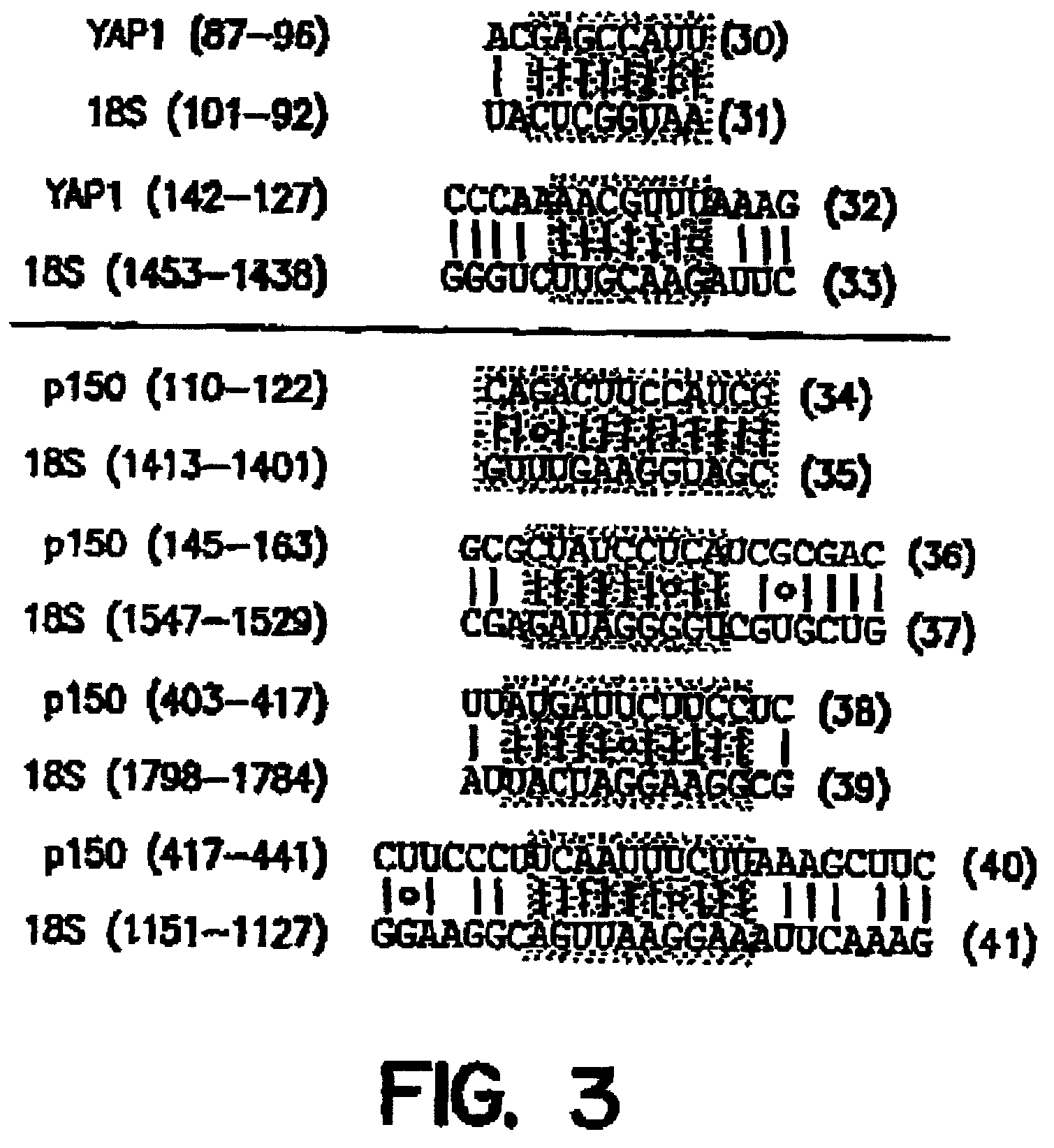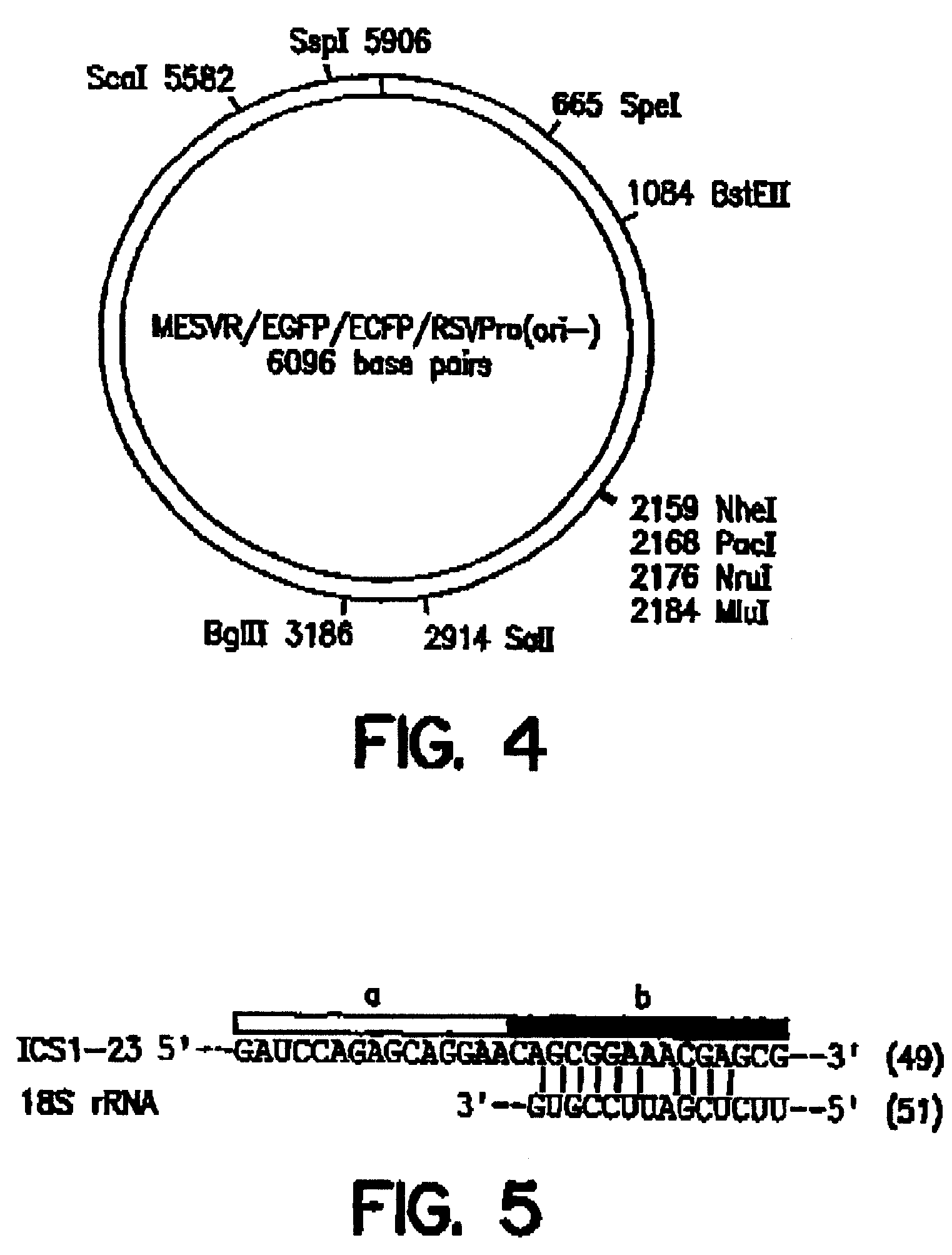Synthetic internal ribosome entry sites and methods of identifying same
a technology of ribosome entry site and ribosome nucleotide sequence, which is applied in the direction of organic chemistry, enzymology, etc., can solve the problems of reducing the expression of rna, and not always correlated with the amount of protein translated from the rna directly, so as to facilitate the expression or facilitate the expression of therapeutic polypeptides, and facilitate the activity of therapeutic polypeptides
- Summary
- Abstract
- Description
- Claims
- Application Information
AI Technical Summary
Benefits of technology
Problems solved by technology
Method used
Image
Examples
example 1
Identification of a Modular IRES Element That Enhances Translational Activity
[0106]This example describes the identification and characterization of a nine nucleotide IRES element from the 5′ untranslated region (5′ UTR) of the mRNA encoding the Gtx homeodomain protein.
A. Identification of a Nine Nucle tide IRES Element in the Gtx 5′ UTR
[0107]Dicistronic constructs were based on the pGL3-R2 (RP) and pGL3-R2 h (RPh) dicistronic reporter vectors (Chappell et al., Proc. Natl. Acad. Sci. USA 97:1536-1541, 2000, each of which is incorporated herein by reference; see, also, Stoneley et al., supra, 1998). These vectors encode a dicistronic mRNA, with the Renilla (sea pansy) luciferase gene upstream of the Photinus (firefly) luciferase gene. An SV40 promoter and enhancer drive expression. The RPh vector contains a 60 bp inverted repeat located 5′ (upstream) of the first cistron. The 5′ UTR of the Gtx mRNA (SEQ ID NO: 1; Komuro et al., supra, 1993) was synthesized as two overlapping oligonuc...
example 2
Identification and Characterization of IRES Elements From Dendrictically Localized RNA Molecules
[0122]This example demonstrates that RNA molecules that localize in dendrites contain 5′ UTR nucleotide sequences that act as internal ribosome binding sites (IRESes)[0123]A. Vector and Cell Lines
[0124]The 5′ untranslated regions (5′ UTRs) from the alpha subunit of Cam Kinase II (CamK IIa; SEQ ID NO: 23), dendrin (SEQ ID NO: 24), the activity-regulated cytoskeletal protein (ARC; SEQ ID NO: 25), microtubule-associated protein 2 (MAP2; SEQ ID NO: 26) and neurogranin (RC3; SEQ ID NO: 27) were obtained by RT-PCR amplification of rat adult hippocampal cDNA. Amplified 5′ UTRs corresponded to the transcriptional start sites of the mRNAs and ended immediately 5′ to the AUG translation start site. Primers were engineered with restriction endonuclease recognition sites for Eco RI and Nco I, to allow for directional cloning into the dicistronic vectors, RP and RPh, each of which encodes Renilla luci...
example 3
Identification of Translational Regulatory Elements That are Active in Growing Yeast Cells
[0168]This example demonstrates that translational regulatory elements are present in mRNAs encoded in yeast cells, and that isolated elements of the yeast mRNA sequences have translational regulatory activity in vegetatively growing yeast cells.
[0169]In higher eukaryotes, translation of some mRNAs occurs by internal initiation. It is not known, however, whether this mechanism is used to initiate the translation of any yeast mRNAs. As disclosed herein, naturally occurring nucleotide sequences that function as IRES elements within the 5′ leader sequences of Saccharomyces cerevisiae YAP1 and p150 mRNAs were identified. When tested in the 5′ UTRs of monocistronic reporter genes, both leader sequences enhanced translation efficiency in vegetatively growing yeast cells. Moreover, when tested in the intercistronic region of dicistronic mRNAs, both sequences exhibited IRES activity that functioned in ...
PUM
 Login to View More
Login to View More Abstract
Description
Claims
Application Information
 Login to View More
Login to View More - R&D
- Intellectual Property
- Life Sciences
- Materials
- Tech Scout
- Unparalleled Data Quality
- Higher Quality Content
- 60% Fewer Hallucinations
Browse by: Latest US Patents, China's latest patents, Technical Efficacy Thesaurus, Application Domain, Technology Topic, Popular Technical Reports.
© 2025 PatSnap. All rights reserved.Legal|Privacy policy|Modern Slavery Act Transparency Statement|Sitemap|About US| Contact US: help@patsnap.com



